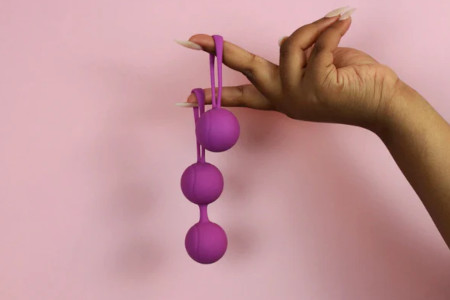
What Kegel Balls are: How in 4 Steps and Their Benefits
Kegel balls are small, weighted devices that can strengthen your pelvic floor muscles, reduce urinary incontinence, and even enhance sexual satisfaction.
Have you ever been caught off guard by a sneeze or a good laugh and found yourself rushing to the bathroom? Or maybe you’ve experienced that subtle but frustrating lack of control that can come from a weak pelvic floor? It’s something no one talks about but affects so many. And here’s the thing, no matter your age or gender, your pelvic floor muscles are a hidden powerhouse that influences your everyday comfort, confidence, and even your core strength.
Imagine being able to laugh freely, exercise confidently, and feel truly in control. Strengthening your pelvic floor can make that possible, and it’s easier than you might think. From simple exercises you can do at home to innovative solutions like the Elitone device, which does the work for you, there are plenty of ways to reclaim your pelvic strength.
Let’s explore what it takes to build a stronger, more resilient pelvic floor so you can avoid those “oops” moments. Taking charge to strengthen your pelvic floor? Let’s go!
The pelvic floor is a group of muscles located at the base of your pelvis, forming a hammock-like support structure. These muscles support vital organs, including the bladder, uterus, and intestines, keeping them in place and aiding in essential bodily functions. When the pelvic floor muscles weaken, issues such as urinary incontinence, lower back pain, and decreased sexual satisfaction may arise. Strengthening these muscles helps avoid these problems and offers a greater sense of control over bodily functions.
Pelvic floor weakness can result from various factors, such as:
Fortunately, strengthening the pelvic floor is possible at any stage of life. Here’s how to strengthen your pelvic floor.
Kegel exercises are the most well-known and effective way to engage and strengthen the pelvic floor. Developed by Dr. Arnold Kegel in the 1940s, these exercises specifically target the pelvic muscles.
Consistency is key with Kegel exercises. It may take weeks to notice improvement, but with persistence, many people experience better control and strength in their pelvic floor. Have a hard time doing it correctly or keeping up with it? Read on.
The bridge exercise, though not a Kegel, helps target the glutes and lower core, which support the pelvic floor muscles.
Bridges, along with Kegels, can boost the overall strength and stability of your pelvic region, giving extra support to those vital muscles.
Squats are another powerful exercise for pelvic health, as they strengthen both the core and lower body.
Squats provide an excellent full-body workout, which strengthens the glutes, hips, and pelvic floor while enhancing balance and stability.
While traditional exercises like Kegels, bridges, and squats are effective, keeping up with a consistent regimen can be challenging. That’s where Elitone comes into play. Elitone is a wearable device designed to help tone your pelvic floor without requiring you to do the exercises manually.
Elitone uses gentle, effective pulses to stimulate the pelvic floor muscles, mimicking the effects of Kegel exercises. With a simple, comfortable fit, it delivers precise, timed contractions to help strengthen these muscles in an easy, hands-free manner.
Advantages of Elitone:
Elitone provides a modern solution for pelvic floor toning, making it easier than ever to prioritize your pelvic health.
Pilates is a fantastic exercise method that focuses on core strength, flexibility, and balance, all of which support pelvic health. Pilates movements often emphasize controlled breathing and alignment, enhancing muscle engagement around the pelvic floor.
Pilates offers gentle yet effective pelvic floor strengthening that can also benefit other areas of the body, enhancing posture and flexibility.
Strengthening your pelvic floor isn’t only about physical exercise. Learning to relax and engage these muscles mindfully can help optimize your results. Deep breathing, particularly diaphragmatic breathing, can enhance relaxation and encourage pelvic floor release.
Mindfulness and breathing exercises reduce tension in the pelvic floor, which complements your strengthening efforts by maintaining a balanced muscle tone.
Good nutrition and maintaining a healthy weight play a vital role in pelvic floor health. Excessive weight can increase pressure on the pelvic floor, contributing to its weakness over time. Eating a balanced diet rich in fiber, vitamins, and minerals helps prevent constipation, a common issue that can strain the pelvic muscles.
Consider adding more fiber-rich foods like fruits, vegetables, and whole grains to support digestive health and reduce pelvic strain. Staying hydrated and engaging in regular exercise will also contribute to your pelvic floor’s overall well-being.
Strengthening your pelvic floor is more than a few exercises; it’s about making lifestyle adjustments that protect and support these muscles. Here are some tips:
A strong pelvic floor is crucial for overall health, comfort, and quality of life. Incorporating Kegel exercises, Pilates, core strengthening moves, and lifestyle adjustments will go a long way toward achieving better pelvic floor strength. And if you’re looking for a modern, hassle-free approach, Elitone can be a great addition to your pelvic health routine, providing hands-free, targeted stimulation for efficient toning. Remember, consistency is key, so stick with these tips, and in time, you’ll experience the benefits of a strong, healthy pelvic floor.
References:
Herderschee, Roselien, et al. “Feedback or biofeedback to augment pelvic floor muscle training for urinary incontinence in women.” Cochrane Database of Systematic Reviews 2011.7 (1996).
Newman, Diane K. “Pelvic floor muscle rehabilitation using biofeedback.” Urol Nurs 34.4 (2014): 193-202.
https://elitone.com/resources